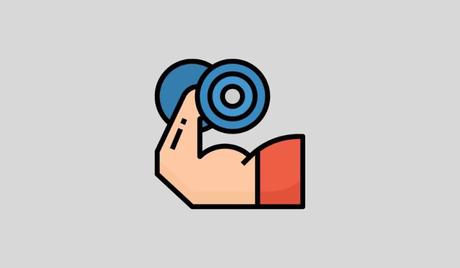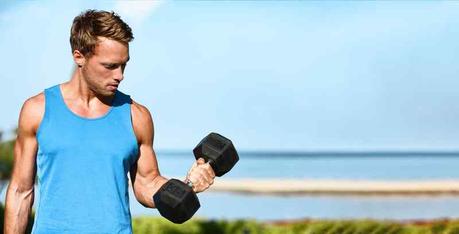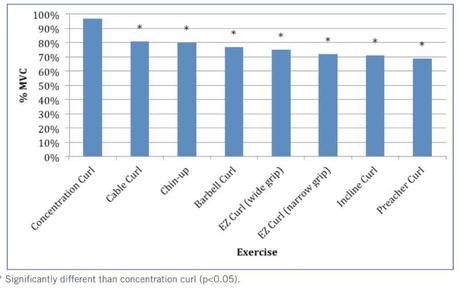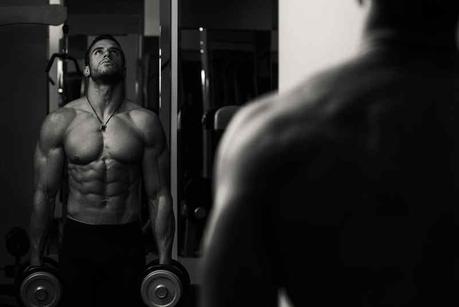Get more from arms day with this detailed look at the best dumbbell biceps exercises, including why you should use DBs for booking your ticket to the gun show.

There are a lot of great reasons to train biceps, from looking good in a t-shirt to improving elbow flexion.
In this guide, we are going to look at the top dumbbell biceps exercises.
Everyone knows about the standard dumbbell bicep curl, but this guide will go further than that.
We’ll look at the most effective DB exercise for bicep growth, how to change your curls for overall arm muscle growth, and much more.
Additionally, we’ll look at some reasons why training with dumbbells is better than barbells, step-by-step instructions for each exercise, and so on.
By the end, you will have everything you need for maximizing your time in the gym and filling out the sleeves of your shirt.
Let’s jump right in.
- Benefits of Using Dumbbells for Training the Biceps Muscles
- Best Dumbbell Exercises for Stronger Biceps
- 1. Dumbbell concentration curls
- 2. Hammer Curls
- 3. Incline Curls
- 4. Single arm curls
- 5. Fat Grip Curls
- Tips for Getting the Most from Your DB Bicep Training
Benefits of Using Dumbbells for Training the Biceps Muscles
Before we get to the salty goodness of exercises, it’s helpful to understand why using dumbbells for getting after your biceps is an excellent choice.
Here’s why I love using DBs for strength training and biceps development:
 Unilateral training.
Unilateral training.

Unilateral training—using one side of your body at a time to complete an exercise—is a super underrated form of strength training.
Unilateral training helps identify muscle imbalances (more on that in a hot second) but is also a great way to increase muscle-mind connection, increase time under tension (more muscle recruitment and more calories burned), and helps develop those valuable core and stabilizer muscles1.
Whether you bang out ten reps at a time per side, or alternate between arms for 20, dumbbells have the distinct advantage over bars in that they allow you to train unilaterally.
 Reduced likelihood of injury.
Reduced likelihood of injury.

Spend enough time in the gym, you are going to get injured. That’s just a reality of pushing the body to its limits on the regular.
Dumbbells can help reduce the likelihood because you can train one side at a time, addressing muscle imbalances2.
Research has consistently shown that muscle imbalances are a leading cause of injury with athletes3.
While barbells will always rule the roost in terms of peak power, dumbbells are an essential tool in your strength building and injury-reduction toolkit.

 Grip variety.
Grip variety.

One of the reasons I love dumbbells so much is that you can use a grip that is comfortable.
Straight bars like barbells can cause strain in the elbows and wrists for some lifters and dumbbells allow for a more natural grip. Additionally, different grips mean different training stimuli.
A semiprone grip (palms facing in) and prone (palms facing back) significantly increase the demand on the forearms when holding weights.
This is a serious two-for-one when doing biceps exercises with dumbbells.
 Portable and compact.
Portable and compact.

Finally, dumbbells are easier to use, require less equipment, and you can set yourself up with them at home with minimal space.
All the benches and weighted bars take at the gym? Grab a set of dumbbells and find yourself a quiet corner to get after it.
Go to a gym that has minimal equipment? You don’t need bells and whistles—just a couple DBs.
Want to build out a home gym but don’t have a lot of room? Pick yourself up a pair of adjustable dumbbells and maximize your time and space with home workouts.
More Dumbbell Guides
What Weight Dumbbells Should I Buy?
How Much Do Dumbbells Cost? (And Why Are They So Expensive?)
While weight is weight, dumbbells, for a variety of reasons (some listed above, many others not), are an excellent choice for targeting the biceps muscles.
Best Dumbbell Exercises for Stronger Biceps
1. Dumbbell concentration curls

Want to completely isolate the biceps for maximum muscle recruitment in the biceps brachii?

Look no further than the concentration curl.
This dumbbell exercise TOTALLY isolates the biceps, reducing other supporting muscles—like the anterior deltoid—from compensating in the exercise.
A study1 commissioned by the American Council on Exercise looked at eight common biceps exercises, including chin ups, barbell curls, cable curls, and preacher curls, and found that concentration curls were far and away the best at generating muscle activation in the biceps brachii.

I also love this exercise as it prevents you from cheating by potentially swinging the weight to bang out a few extra reps or more range of motion.
Here are some tips for making the most of this bicep-building monster:
- Grab a weight bench and have a set
- With your DB of choice, push your working elbow against your thigh, creating an anchor
- Curl the weight up, contracting the biceps along the way
- Pause at the top to squeeze every last bit of muscle contraction you can
- Lower (not drop) to the starting position, without locking out your elbow to maintain tension
- Repeat as necessary
Note that because you are targeting the biceps exclusively with this exercise, you won’t be able to go as heavy as you can with other bicep staples like bar curls, which use a lot of other muscles in the shoulders (anterior deltoids) and arms.
2. Hammer Curls
Building large and strong biceps muscles is great and all, but we don’t want to be that lifter that has huge bi’s but weak forearms and grip.
For better overall arm strength and muscle development, look no further than hammer curls.
This dumbbell exercise, which uses a neutral grip (palms facing each other) that is easier on the wrists, are awesome for developing forearm and gripping strength.
Prone and semiprone forearm positions are more effective at activating muscles in the brachioradialis2 (science for forearms) compared to a regular grip.
How to do DB hammer curls like a pro:
- Grab a set of your favorite dumbbells
- Get into an athletic stance (knees slightly bent, back straight, core engaged)
- With palms facing the body (this is a semiprone forearm position), bring the weight up
- Contract the biceps and forearms through the movement
- Pause just before the biceps slackens and hold for a moment
- Slowly lower to starting position
- Repeat as necessary
This exercise, like just about every other dumbbell exercise, can be done standing or sitting.
Additionally, you can really enhance the mind-muscle connection by doing it unilaterally—one side at a time—and also recruiting more of the stabilizer muscles in your core.
3. Incline Curls
The incline bicep curl is a twist on the standard bicep curl.
By leaning back on a weight bench on an incline, we change the shoulder angle and also change the demand on our biceps.
One paper1 looked at the differences between a standing dumbbell curl, preacher curl and an incline curl (with the bench set at 50-degrees).
The incline version performed best during the middle part of the concentric phase (this is when the dumbbell is being curled up), making it an ideal exercise for lifters who are wanting to improve that specific part of the lift.
See also: 5 Best Dumbbell Lat Exercises for a Strong, Muscular Back
From personal experience, incline curls are a great way to reduce swinging in the upper body that happens a lot during standing curls.
Here’s how to an incline curl like a boss:
- Set your adjustable weight bench to a 45-50 degree angle
- Pick up your dumbbells
- Lift with control, curling the dumbbell towards your shoulders
- If your biceps slacken, you’ve raised the dumbbells too high
- Pause under maximum contraction
- Slowly lower the dumbbell
- Repeat as necessary
Key mistakes to avoid include not swinging the weights and also not going too heavy the first time you try this exercise.
Because your body is parked on the bench, you won’t be able to recruit the shoulders or upper body to help you power through the lift.
Instead of focusing on lifting a lot of weight, focus on getting the best contraction possible with this dumbbell exercise.
4. Single arm curls
Training unilaterally (one side at a time) is a proven way to solicit more muscle activation throughout your core.
By off-setting the weight on one side of the body, we fire up all of those stabilizer muscles that keep us from tipping over.
Single arm curls are also great for really focusing on technique and form, getting every last bit of contraction out of our muscles, and spending more time under tension (burning more calories).
I also like unilateral training as it forces us to be honest about addressing muscle imbalances in the body.
Every lifter, regardless of ability, should incorporate unilateral lifts into their workouts regularly to stay on top of muscle imbalances, which will help reduce injury in the long haul.
How to do single arm curls:
- Grab a dumbbell and get into a proper stance
- Curl the weight, making sure to keep your core braced and body balanced
- Avoid the urge to twist the spine to compensate for off-set weight
- Lift to the top of the range of motion, contracting the biceps the whole way
- Pause for a moment
- Slowly lower to the starting position
- Repeat as necessary
Lifting one side at a time can be humbling for some lifters—you suddenly realize that your non-dominant side is trailing significantly in terms of strength.
And lifting this way doubles the amount of time it takes to complete a set.
But including a few unilateral sets and reps into each lifting session can go a long way to maximizing your efforts in the gym.
5. Fat Grip Curls
Runner up for developing stronger forearms and overall arm size
Want to take your arm training to the next level? Add some fat-grip training to the mix for maximum forearm activation.
Fat grip training essentially means we use a thicker barbell or dumbbell, increasing the grip required to hold onto the weight.

Until recently, this meant hoping that your local gym stocked thick bars (much less dumbbells).
But now, with the advent of rubber bar thickeners (see my list of the top thick bar grips here), we can make any handle in the gym thicker. Including dumbbells.
How to do fat grip curls:
- Grab your dumbbell of choice
- Wrap it with a thick grip
- Raise the weight, careful to feel max contraction through the forearms and biceps throughout
- Pause at the top
- Lower in a controlled manner
- Repeat as necessary (or until your forearms tap out )

Fat grip curls are a good way to lessen demand on the elbows and improve your grip, which will help your bigger pulling lifts like deadlifts and weighted pull ups.
For even more forearm activation, use an overhand grip on the dumbbell (also known as a Zottman curl).
Tips for Getting the Most from Your DB Bicep Training
A lot of people waste time and effort when it comes to building stronger biceps in the gym.
The two main things it comes down to is being mindful of the movement and programming your workout properly.

If you ever find yourself rushing through a workout, your upper body beginning to swing, just whisper the words contract and control to yourself.
Hucking weights around, cheating through reps, and disregarding control may get you a few more pounds on the DB, but you are missing out on serious muscular growth.
Slow it down (use a tempo of 2-1-2, for example), really feel the contraction in your biceps, and you will save time (full attention and contraction mean doing fewer reps to hit failure) and grow those biceps much faster.

Where you place DB bicep exercises in your workout will heavily influence how much weight you can pull and curl.
If you have a big pulling day (deadlifts, weighted pull-ups, rack pulls, etc), save the biceps exercises for later in the workout.
Leading off the day with isolation exercises limits how much you will be able to do on the big compound lifts when you are focused on peak power and not necessarily hypertrophy.
That said, if you are there purely for hypertrophy of the biceps, by all means, lead the workout off with them as you will be fresh and primed to lift to the peak of your ability.
The Bottom Line
No matter what your goals are with training your biceps, whether it’s purely aesthetic or you want an accessory exercise to strengthen your forearms and grip, there is a dumbbell exercise for you.
The best part is that you don’t even need a ton of equipment (many of these exercises the dumbbells can be subbed in with a resistance band, for example) to achieve a solid swell in the biceps.
Choose a couple of the exercises above to incorporate into your training regimen, match them up to your overall goals, and get to lifting!
More Guides Like This
6 Best Cable Machine Exercises for Arms. In this guide, we look at the best cable exercises you can do for sculpting both the triceps and biceps muscles.
7 Best Dumbbell Exercises for a Strong Back (Plus Benefits and a 20-Minute Back Workout). Take your back workouts to the next level with these killer dumbbell back exercises, plus benefits of using DBs and a sample 20-minute back workout you can do with dumbbells.
